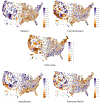Regional personality assessment through social media language
- PMID: 34536229
- PMCID: PMC9714561
- DOI: 10.1111/jopy.12674
Regional personality assessment through social media language
Abstract
Objective: We explore the personality of counties as assessed through linguistic patterns on social media. Such studies were previously limited by the cost and feasibility of large-scale surveys; however, language-based computational models applied to large social media datasets now allow for large-scale personality assessment.
Method: We applied a language-based assessment of the five factor model of personality to 6,064,267 U.S. Twitter users. We aggregated the Twitter-based personality scores to 2,041 counties and compared to political, economic, social, and health outcomes measured through surveys and by government agencies.
Results: There was significant personality variation across counties. Openness to experience was higher on the coasts, conscientiousness was uniformly spread, extraversion was higher in southern states, agreeableness was higher in western states, and emotional stability was highest in the south. Across 13 outcomes, language-based personality estimates replicated patterns that have been observed in individual-level and geographic studies. This includes higher Republican vote share in less agreeable counties and increased life satisfaction in more conscientious counties.
Conclusions: Results suggest that regions vary in their personality and that these differences can be studied through computational linguistic analysis of social media. Furthermore, these methods may be used to explore other psychological constructs across geographies.
Keywords: big data; language; measurement; personality assessment; social media.
© 2021 Wiley Periodicals LLC.
Conflict of interest statement
Declaration of Conflicting Interests
The authors declared no potential conflicts of interest with respect to the research, authorship, and/or publication of this article.
Figures



Similar articles
-
Personality Homophily and Geographic Distance in Facebook.Cyberpsychol Behav Soc Netw. 2018 Jun;21(6):361-366. doi: 10.1089/cyber.2017.0615. Epub 2018 May 24. Cyberpsychol Behav Soc Netw. 2018. PMID: 29792523
-
Individual-Level Analyses of the Impact of Parasite Stress on Personality: Reduced Openness Only for Older Individuals.Pers Soc Psychol Bull. 2020 Jan;46(1):79-93. doi: 10.1177/0146167219843918. Epub 2019 May 3. Pers Soc Psychol Bull. 2020. PMID: 31046588
-
Personality Traits and Social Media Use in 20 Countries: How Personality Relates to Frequency of Social Media Use, Social Media News Use, and Social Media Use for Social Interaction.Cyberpsychol Behav Soc Netw. 2017 Sep;20(9):540-552. Cyberpsychol Behav Soc Netw. 2017. PMID: 28922034
-
How big five personality traits influence information sharing on social media: A meta analysis.PLoS One. 2024 Jun 12;19(6):e0303770. doi: 10.1371/journal.pone.0303770. eCollection 2024. PLoS One. 2024. PMID: 38865331 Free PMC article.
-
An introduction to the five-factor model and its applications.J Pers. 1992 Jun;60(2):175-215. doi: 10.1111/j.1467-6494.1992.tb00970.x. J Pers. 1992. PMID: 1635039 Review.
Cited by
-
The psychological impacts of the COVID-19 pandemic on business leadership.PLoS One. 2023 Oct 11;18(10):e0290621. doi: 10.1371/journal.pone.0290621. eCollection 2023. PLoS One. 2023. PMID: 37819914 Free PMC article.
-
Filling in the white space: Spatial interpolation with Gaussian processes and social media data.Curr Res Ecol Soc Psychol. 2023;5:100159. doi: 10.1016/j.cresp.2023.100159. Epub 2023 Oct 12. Curr Res Ecol Soc Psychol. 2023. PMID: 38125747 Free PMC article.
-
Opioid death projections with AI-based forecasts using social media language.NPJ Digit Med. 2023 Mar 8;6(1):35. doi: 10.1038/s41746-023-00776-0. NPJ Digit Med. 2023. PMID: 36882633 Free PMC article.
-
Robust language-based mental health assessments in time and space through social media.NPJ Digit Med. 2024 May 2;7(1):109. doi: 10.1038/s41746-024-01100-0. NPJ Digit Med. 2024. PMID: 38698174 Free PMC article.
-
Predicting U.S. county opioid poisoning mortality from multi-modal social media and psychological self-report data.Sci Rep. 2023 Jun 3;13(1):9027. doi: 10.1038/s41598-023-34468-2. Sci Rep. 2023. PMID: 37270657 Free PMC article.
References
-
- Allik J, & McCrae RR (2004). Toward a geography of personality traits: Patterns of profiles across 36 cultures. Journal of Cross Cultural Psychology, 35, 13–28.
-
- Arbia G (2014). A primer for spatial econometrics with applications in R. Palgrave Macmillan.
-
- Benjamini Y, & Hochberg Y (1995). Controlling the false discovery rate: a practical and powerful approach to multiple testing. Journal of the Royal statistical society: series B (Methodological), 57(1), 289–300.
Publication types
MeSH terms
Grants and funding
LinkOut - more resources
Full Text Sources

